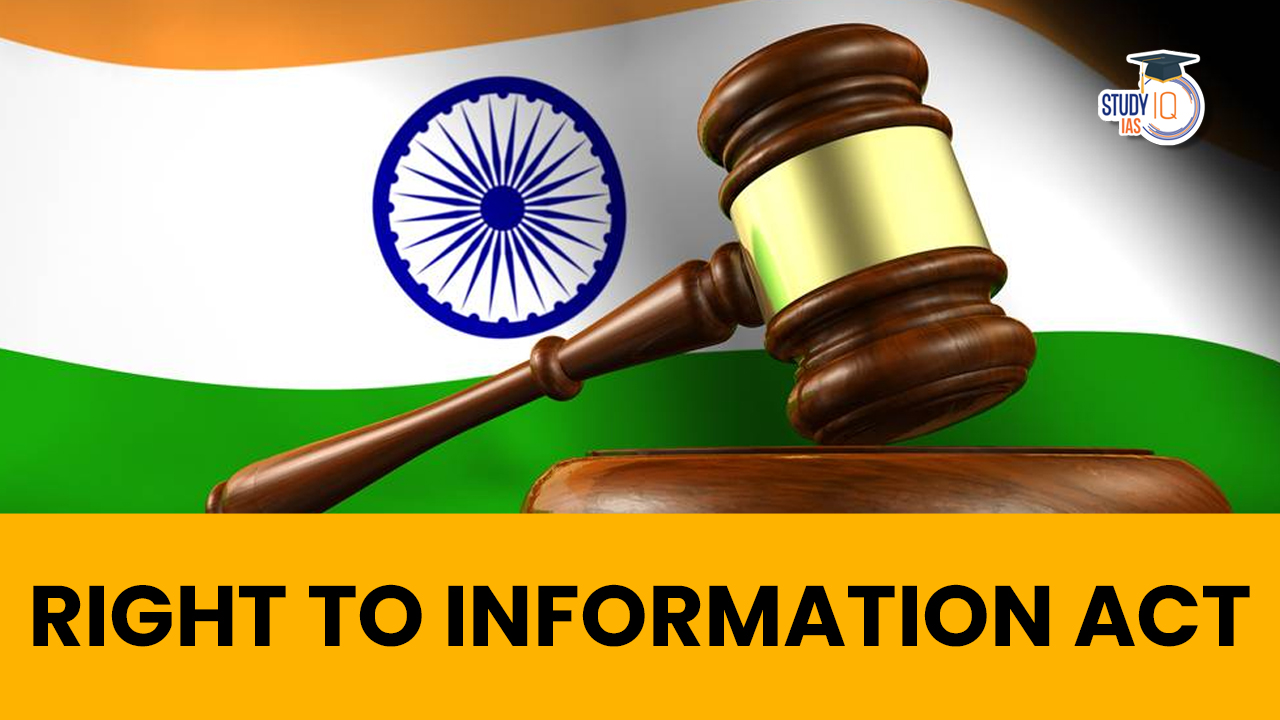Table of Contents
Context: Recent amendments in the RTI Act via the Digital Personal Data Protection (DPDP) Act, 2023, have raised concerns over potential dilution of transparency by restricting access to certain personal information.
The Right to Information (RTI) Act ensures everyone the freedom to access information and opinions about any topic through any media, across all barriers. Enacted as part of the Universal Declaration of Human Rights in 1948, significant amendments were made to the RTI Act in 2005. This act is a cornerstone of Indian Polity, a crucial subject in the UPSC syllabus. For aspirants, practising with UPSC Mock Tests can enhance preparation accuracy.
Right to Information (RTI)
Article 19(1) of the Indian Constitution recognises the Right to Information (RTI) as a fundamental right. In the important case of Raj Narain v. State of Uttar Pradesh (1976), the Supreme Court confirmed that this right is part of Article 19. The court stressed that in a democracy, citizens should know how their government operates. As a result, the Right to Information Act was passed in 2005, creating a system for people to use this fundamental right.
- It is regarded as a landmark legislation in Indian democracy, which has:
- Enhanced accountability and transparency in governance.
- Empowered citizens to seek information from public authorities.
- Over the past two decades, RTI has made governance more participatory and answerable to the public.
- As per the 2nd ARC report, ‘RTI is the master key for good governance’
Changes introduced by the DPDP Act
Section 44(3) of the DPDP Act amends Section 8(1)(j) of the RTI Act.
- This amendment allows public authorities to deny access to “personal information” without any consideration of public interest.
- The DPDP Act replaces this clause with a broader exemption that simply states that any “personal information” is exempt from disclosure, removing the “larger public interest” test.
Original RTI Provision
- Section 8(1)(j) of the RTI Act permits withholding of personal information only if:
- Disclosure would invade privacy.
- It is not related to public activity or interest.
- Safeguard Clause: Even such personal information can be disclosed if a larger public interest justifies it.
- Eg. caste certificates or educational degrees of public servants.
Concerns Raised by Civil Society & Experts
- Restriction on Public Information Access: The previous provision allowed disclosure of personal information if it was in the public interest (E.g. government officers’ assets and liabilities).
- Impact on RTI Decisions and Precedents: Over the years, several decisions of the Central Information Commission (CIC) and state Information Commissions have been based on the “public interest” clause in Section 8(1)(j).
- The new provision removes the discretion to allow access to such data, affecting these past rulings.
- Changing the RTI Act via another law (DPDP) was not the intent of the K.S. Puttaswamy judgment.
- Possible Consequences of the Amendment:
- It will reduce transparency in governance.
- Increased difficulty in accessing information about public servants and officials.
- Weakening of the RTI Act in holding the government accountable.
| Related Committees & Cases |
|
Supreme Court to Decide on Crucial RTI Issue
The Supreme Court is looking into a public interest case about whether people have to submit documents again during a second appeal under the Right to Information (RTI) Act if they have already submitted them in a first appeal. A bench led by Chief Justice DY Chandrachud has asked the responding authority to reply to this question.
The person who filed the case argues that resubmitting documents is unnecessary and makes things harder for citizens. On the other hand, the authority might say that it helps ensure all important information is included. The Court’s decision will clarify an important part of the RTI Act, affecting how appeals are handled and how easily people can access information.
History of Constitutional Recognition of the Right to Information in India
The Right to Information (RTI) is not explicitly mentioned as a fundamental right in the Constitution. However, the Supreme Court has linked it to Article 19(1)(a), which guarantees freedom of speech. It is also related to Article 21, concerning the Right to Life and Personal Liberty.
The RTI movement, led by the Mazdoor Kisan Shakti Sangathan (MKSS), along with judicial support, resulted in the Right to Information Act of 2005. This Act allows citizens to request information from public authorities, fostering transparency and accountability.
| History of RTI Act | |
| State of U.P. v Raj Narain (1975) | SC held that the right is implicit in the right to freedom of speech and expression, explicitly guaranteed in Article 19 of the Indian Constitution. |
| S.P. Gupta v. President of India (1982) | SC asserted the right of the people to know about every public act and the details of every public transaction undertaken by public functionaries. |
| People’s Union for Civil Liberties v. Union of India case | SC elevated the status of right to information to a human right and linked it to the right to life enshrined in Article 21 of the Constitution. |
Objective of RTI Act
The RTI Act aims to empower citizens,
- foster transparency and accountability in governmental operations,
- combat corruption, and
- ensure that democracy serves the people effectively.
An informed citizenry is better equipped to scrutinise governance mechanisms and hold the government accountable.
Features of RTI Act
- Citizen’s Right to Information: Any Indian citizen can request information from a public authority. The information must be provided within 30 days.
- Public Information Officers (PIOs): Each public authority must appoint PIOs to handle information requests.
- Digitization of Records: Government agencies are encouraged to digitise records for wider public access.
- Exemptions: The RTI Act does not apply to Jammu and Kashmir, which has its own RTI Act of 2009. Certain intelligence and security agencies are also exempt.
- Three-tier Enforcement System: This includes the Public Information Officer, First Appellate Authority, and Central Information Commission (CIC). Appeals can be made if information is not provided within 30 days, with a further appeal possible within 90 days if necessary.
Need for Right to Information (RTI)
The RTI Act is important for maintaining transparency and accountability in government operations. It grants citizens the right to access information held by public authorities, fostering an environment where misuse of information is minimised. This act is especially helpful for marginalised communities, allowing them to ask questions about government policies and programs that affect their well-being. The RTI Act has also played a key role in uncovering corruption in different areas.
Key Sections of RTI Act 2005
- Section 2(h): Defines ‘public authorities’ including all agencies and organisations under the union, state, or local body jurisdiction.
- Section 3: Provides that every citizen has the right to information under the Act.
- Section 4(1)(b): Mandates proactive disclosure and updating of information by the government.
- Section 6: Outlines a simple process for securing information.
- Section 7: Specifies the time limit for PIOs to provide information.
- Section 8: Lists exemptions under which information can be denied.
- Section 8(1)(j): Exempts disclosure of personal information unless it is in the larger public interest or unless the same information would be provided to Parliament or the State Legislature.
- Section 19: Provides for a two-tier appellate mechanism:
- First appeal to the senior officer in the public authority.
- Second appeal to the Central or State Information Commission.
- Section 20: Imposes penalties for failing to provide timely, accurate, or complete information.
- Section 23: Excludes lower courts from jurisdiction over RTI disputes, preserving the writ jurisdiction of the Supreme Court and High Courts.
Challenges of the RTI Act
- Misuse of the Right: Some people use RTI requests for personal gain or to harass public authorities, rather than for genuine public interest. For example, filing RTIs to gain publicity or pressure officials.
- RTI vs Official Secrets: Certain government actions require secrecy to protect national interests. For instance, seeking information about the Rafael aircraft procurement could reveal sensitive details to hostile neighbours.
- RTI vs Right to Privacy: In some cases, RTI conflicts with privacy rights. For example, the government denied information in the electoral bonds scheme to protect donors’ privacy.
- Low Awareness Level: Many people, especially in disadvantaged communities like women in rural areas and OBC/SC/ST groups, have low awareness of their RTI rights.
- Executive Apathy: There has been a lack of support for RTI, particularly with the RTI Amendment Act 2019, which reduced the powers of Chief Information Commissioners and Information Commissioners.
- Non-Application to Political Parties: RTI cannot be used to obtain information from political parties, which are essential to democracy. This lack of transparency poses a serious threat to India’s democratic system.
RTI Act Amendments
The RTI Amendment Act of 2019 introduced some changes:
- Tenure of Chief Information Commissioner: The union government now determines the tenure of the Chief Information Commissioner at the central and state levels.
- Salaries and Allowances: The union government sets the salaries and allowances of the Chief Information Commissioner and Information Commissioners.
- Pension and Retirement Benefits: The amendment removed clauses prohibiting the Chief Information Commissioner and information commissioners from receiving pensions or retirement benefits from prior public service.
Conclusion
The Right to Information Act, 2005, is a powerful tool for citizens to ensure transparency and accountability in government. Despite its challenges, the RTI Act remains a cornerstone of democratic governance, empowering citizens to actively participate in and scrutinize governmental functions.
Sharing is caring!


 SLAPP Suits: Meaning, Examples, Impact o...
SLAPP Suits: Meaning, Examples, Impact o...
 Finance Commission of India, Articles an...
Finance Commission of India, Articles an...
 High Number of Pending Cases in Supreme ...
High Number of Pending Cases in Supreme ...

























